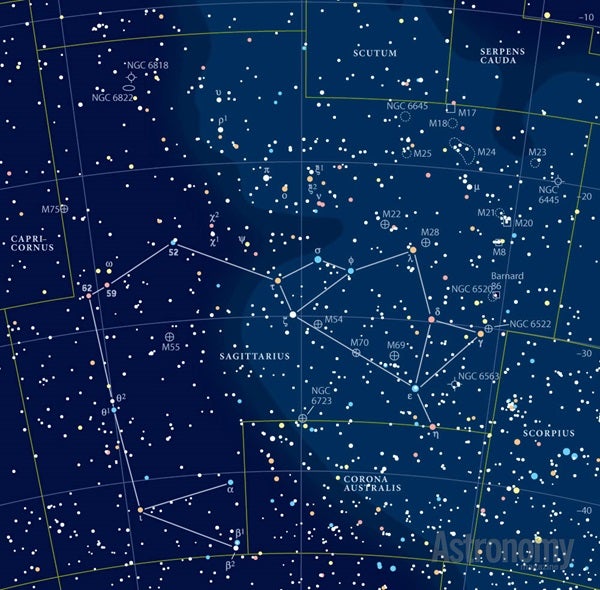Targets for August 28–September 4, 2014
Naked eye and Binoculars: Open cluster M25
Small telescope: The Black Swallowtail Butterfly Cluster (IC 4665)
Large telescope: The Lost in Space Galaxy (NGC 6503)
This week’s naked-eye object is open cluster M25 in Sagittarius. Observers also know this object as IC 4725.
You’ll find it 4.4° east-northeast of magnitude 3.8 Mu (μ) Sagittarii. At magnitude 4.6, M25 is visible to the naked-eye from a dark site, but not easily because of the richness of the Milky Way background. It’s a big cluster, too, measuring 32′ across. That means it covers 6 percent more area than the Full Moon.
Binoculars will let you observe M25 while also revealing the cluster’s stunning stellar surroundings. I find that higher-power binoculars (10x and up) give me a better view because such instruments make the cluster appear larger — thus spreading out its stars — and show less of the Milky Way background.
If you observe M25 through a small telescope at a magnification of 125x, you’ll see 50 member stars. Two chains of stars stretching east to west lie near the center. A starless gap divides them. Many of M25’s stars exceed 11th magnitude, making this a nice sight through such an instrument. Yellow magnitude 6.8 SAO 161557 sits at the cluster’s northwest edge.
Butterflies are free
This week’s small-telescope target is the Black Swallowtail Butterfly Cluster in Ophiuchus. Also known as IC 4665, this open cluster measures 70′ across, meaning it covers slightly more area than five Full Moons. Although its listed magnitude is a bright 4.2, IC 4665’s large size spreads out its light so it may not appear that bright to you.
IC 4665 lies in northern Ophiuchus, 1.3° north-northeast of magnitude 2.8 Beta (β) Ophiuchi. A 4-inch telescope is a great instrument to observe the cluster. Use a low-power eyepiece that will give you at least a 1° field of view. You’ll see several dozen 7th- to 9th-magnitude stars and another 20 stars around magnitude 10 set against a rich background haze of fainter points.
Astronomy magazine Contributing Editor Stephen James O’Meara gave this object the common name I list. He likens IC 4665 to a black swallowtail butterfly, which has a dark body and wings lined with bright white spots, just like the stars in this cluster.
Danger, Will Robinson?
This week’s large-telescope target is the Lost in Space Galaxy in Draco. Also known as NGC 6503, you’ll find this galaxy by starting at magnitude 4.9 Omega (ω) Draconis and moving 1.8° northeast.
At magnitude 10.3, this is a relatively bright spiral galaxy you can spot easily through a 4-inch telescope. But you won’t see much detail through that size instrument. NGC 6503 will display only a broadly concentrated region offset to the north of center.
The surface mottling of this 7.3′ by 2.4′ object becomes apparent through an 11-inch or larger scope under a steady sky. Measurements of the brightest blue stars place NGC 6503 at a distance of 17 million light-years.
When I first heard Stephen James O’Meara’s common name for this object, I thought he was referring to the television series Lost in Space, which ran from 1965 to 1968. As a big fan of science fiction, I loved the perceived tie-in. But no. O’Meara dubbed it the Lost in Space Galaxy simply because of its isolation and neglect by observers.
Expand your observing at Astronomy.com
StarDome
Check out Astronomy.com’s interactive StarDome to see an accurate map of your sky. This tool will help you locate this week’s targets.
The Sky this Week
Get a daily digest of celestial events coming soon to a sky near you.
Observing Talk
After you listen to the podcast and try to find the objects, be sure to share your observing experience with us by leaving a comment at the blog or in the Reader Forums.











